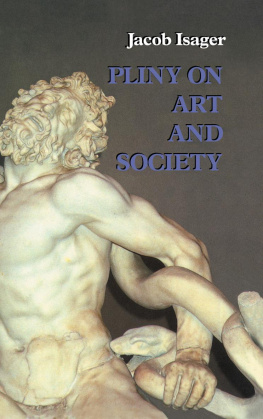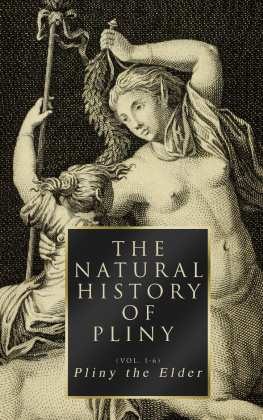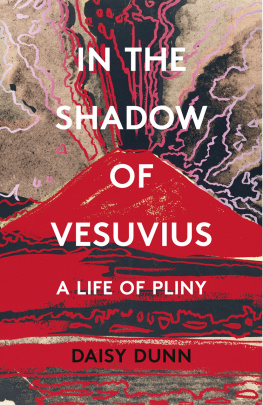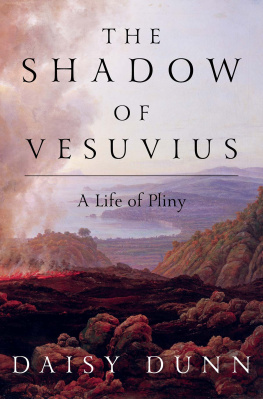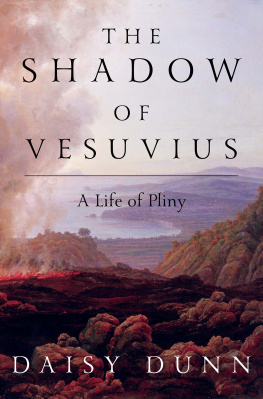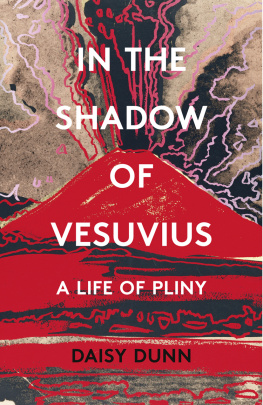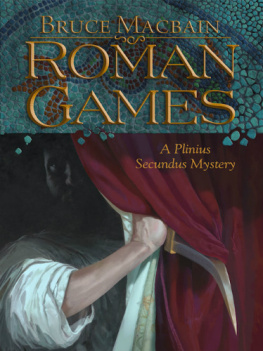P LINY was born in late A.D. 61 or early 62, the son of Lucius Caecilius of Comum. He probably had tutors at home before continuing his education in Rome; there he came in closer contact with his uncle, the polymath Elder Pliny who, on his death in the eruption of Vesuvius which destroyed Pompeii, left the Younger Pliny his estate, having adopted him as a son. Gaius Plinius Luci filius Caecilius Secundus, as he was thereafter known, began his career at the Bar when he was eighteen, and specialized in cases of inheritance. He managed to emerge unscathed from Domitians reign of terror, even being appointed an official at the Treasury, and he held a similar appointment after Domitians death. In 103 he was awarded a priesthood in recognition of his distinguished public service, and was prominent in several major prosecutions. His final senatorial appointment was to represent the Emperor Trajan in Bithynia and Pontus, where he died probably in 113. He was given the consulship at the very early age of thirty-nine, and was married three times. His nine books of personal letters (a social commentary on his times) were selected by Pliny himself and were published in his lifetime, while his official correspondence with Trajan was published as a tenth book after his death and contains the celebrated exchange of letters on the early Christians. Of his many speeches, only the Panegyricus, addressed to Trajan in thanks for his consulship, survives.
BETTY RADICE read classics at Oxford, then married and, in the intervals of bringing up a family, tutored in classics, philosophy and English. She became joint editor of the Penguin Classics in 1964. As well as editing the translation of Livys The War with Hannibal she translated Livys Rome and Italy, the Latin comedies of Terence, The Letters of Abelard and Heloise and Erasmuss Praise of Folly, and also wrote the Introduction to Horaces The Complete Odes and Epodes and The Poems of Propertius, all for the Penguin Classics. She also edited and introduced Edward Gibbons Memoirs of My Life for the Penguin English Library. She edited and annotated her translation of the younger Plinys works for the Loeb Library of Classics, and translated from Italian, Renaissance Latin and Greek for the Officina Bodoni of Verona. She collaborated as a translator in the Collected Works of Erasmus in preparation by the University of Toronto and was the author of the Penguin reference book Whos Who in the Ancient World. Betty Radice was an honorary fellow of St Hildas College, Oxford, and a vice-president of the Classical Association. She died in 1985.

THE
LETTERS
OF
THE
YOUNGER
PLINY

TRANSLATED WITH AN INTRODUCTION BY
BETTY RADICE
PENGUIN BOOKS
PENGUIN BOOKS
Published by the Penguin Group
Penguin Books Ltd, 80 Strand, London WC2R 0RL, England
Penguin Putnam Inc., 375 Hudson Street, New York, New York 10014, USA
Penguin Books Australia Ltd, 250 Camberwell Road, Camberwell, Victoria 3124, Australia
Penguin Books Canada Ltd, 10 Alcorn Avenue, Toronto, Ontario, Canada M4V 3B2
Penguin Books India (P) Ltd, 11 Community Centre, Panchsheel Park, New Delhi 110 017, India
Penguin Books (NZ) Ltd, Cnr Rosedale and Airborne Roads, Albany, Auckland, New Zealand
Penguin Books (South Africa) (Pty) Ltd, 24 Sturdee Avenue, Rosebank 2196, South Africa
Penguin Books Ltd, Registered Offices: 80 Strand, London WC2R 0RL, England
www.penguin.com
This translation first published 1963
Reprinted with Select Bibliography 1969
29
Copyright Betty Radice, 1963, 1969
All rights reserved
Except in the United States of America, this book is sold subject to the condition that it shall not, by way of trade or otherwise, be lent, re-sold, hired out, or otherwise circulated without the publishers prior consent in any form of binding or cover other than that in which it is published and without a similar condition including this condition being imposed on the subsequent purchaser
9780141915944
TO E. V. RIEU
magistro discipula
Contents

Familiar letters written by eye-witnesses, and that, without design, disclose circumstances that let us more intimately into important events, are genuine history; and as far as they go, more satisfactory than formal premeditated narratives.
Horace Walpole to Sir John Fenn, 29 June 1784
Introduction

There is a bareness about an age that has neither letter-writers nor biographers. Virginia Woolf was writing about Dorothy Osborne and the seventeenth century when the bare landscape becomes full of stir and quiver and we can fill in the spaces between the great books with the voices of people talking. The Romans are the first letter-writers of the Classical world, or, rather, theirs are the letters which chance has preserved to satisfy our curiosity about people as persons, each one unpredictable and full of contradictions and different from his fellows. Greek literature keeps the quality of bareness: the great sweeps of thought are there, and the magnificent power to analyse human capacity and weakness, but there is no one, with the possible exception of Socrates, whose personal idiosyncracies are known. We pick up scraps where we can from Aristophanes or Xenophon or Plutarch; and there are the pitiably few undisputed letters of Plato or the touching details of humble persons which survive in the occasional papyrus letter, but no one reveals himself as the true letter-writer never fails to do. So the Greek statue stands aloof with his stylized enigmatic smile, while the Roman portrait bust is recognizably someone like ourselves, and its irregular features speak for a single individual at a point of time.
Roman letters can take many forms. Ciceros poured out freely, without thought of subsequent publication, and the Emperor Marcus Aurelius and his tutor, M. Cornelius Pronto, wrote almost daily to each other letters which are personal and wholly unselfconscious. Horace, Statius and Martial addressed verse letters to their friends; Pliny published his personal letters himself in carefully arranged selections. But it is a fallacy to suppose that only the first type of letter is self-revealing we come to know Chesterfield and Walpole through their letters, if not as intimately as the Pastons or Charles Lamb. Horaces form of letter-essay, which reappears in Montaigne and Addison, never loses its personal note, and Plinys letters have a wealth of autobiographical detail to capture the imagination and fill in the spaces with the voices of people talking.
Cicero is generally thought to be most representative of the great writers of the late Republic, and his letters provide the most revealing information about his times. It is 150 years before the Empire has its letter-writer in Pliny. He has left a more faithful and less prejudiced picture of Rome as he knew it than did any of his contemporaries, and in him we can best see how a Roman of his class lived and thought at the turn of the first century. It is also possible to build up a remarkably complete record of his career and his personal life, for which all the facts come from four inscriptions (the most important of which are translated on pages 3034) and his letters: there are 247 letters in the nine books of the personal correspondence, and 121 official letters to and from the Emperor Trajan published separately in a tenth book.


